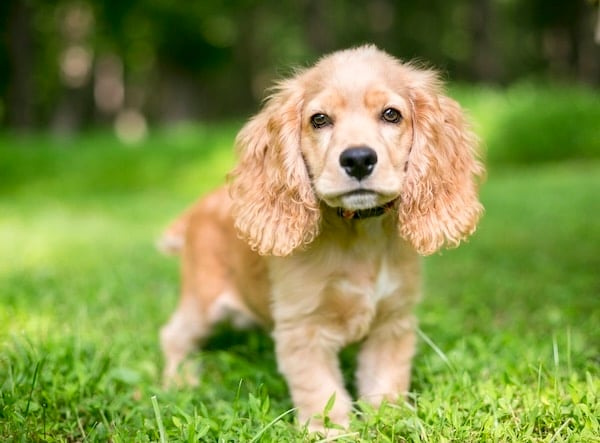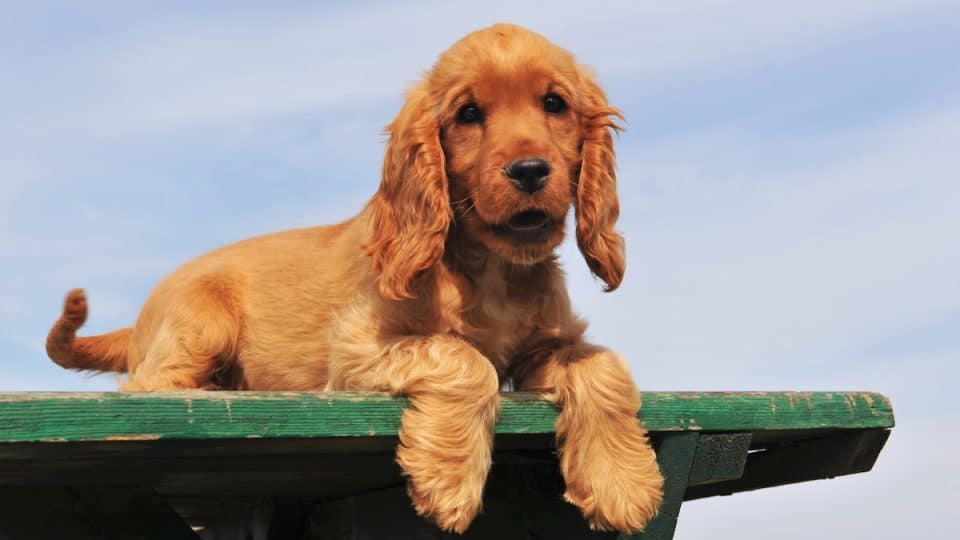- Not a substitute for professional veterinary help.
Thinking about bringing home a Cocker Spaniel puppy? You’re not alone! With big floppy ears and doe eyes, these pups are a popular breed among many families.
As adults, Cocker Spaniels are known for their silky feathered coats—but until they mature, their puppies will sport a soft single layer of fuzz that helps regulate their body temperature. They’ll also be little balls of wild energy until they reach adulthood around age two, when puppy enthusiasm gives way to a gentler joy in games and activity.
Exactly how much exercise it takes to wear out your Cocker Spaniel puppy will depend on a variety of factors, including their breeding. Puppies from working dog lines will often have stronger prey drives than puppies from show lines and will need more intense exercise. Puppies from show and companion lines tend to need more standard levels of puppy entertainment.
Considering bringing a Cocker Spaniel puppy home? Here’s what to know, from where to find one to how fast they grow and the personality traits you can expect to see develop.
Key Cocker Spaniel Puppy Facts
Raising a Cocker Spaniel puppy requires commitment, but these pups make it worthwhile with their loving nature and big puppy dog eyes that will melt your heart.
- Litter size: Cocker Spaniels litters usually average between five and seven puppies.
- Puppy weight: At birth, Cocker Spaniels weigh between a half a pound and a pound. By the time these pups are ready to leave their mothers around 10 weeks, most weigh between 8 and 12 pounds.
- Puppy temperament: Dr. Aimee Warner, a veterinarian at Waggel, describes Cocker Spaniel puppies as family-oriented dogs who are relatively easy to train and thrive on exercise and activity.
- Energy levels: These energetic pups require ample physical and mental stimulation to satisfy their curiosity and drive, which stems from their sporting dog heritage. When not given the exercise and enrichment they need, these puppies are prone to destructive behaviors.
- Maturity: Although the puppy antics will subside once this breed reaches about two years old, these dogs always carry a zest for life, especially when adventuring and spending time with their humans.
- Unique traits: These happy pups express their joy with an enthusiastic tail wag that takes over their whole body. This excitement, paired with the retriever drive, can make these puppies quite nippy, so it’s a good idea to teach them mouth manners early on.
- Bonding likelihood: Unlike some other affectionate breeds who tend to choose just one human, Cocker Spaniel puppies have lots of love to share and can form strong bonds with multiple family members, including children.
Where To Find Cocker Spaniel Puppies
The Cocker Spaniel is a popular breed, making it relatively easy to find puppies—though demand can increase wait times. If you get your puppy from a breeder, expect to pay between $1,000 and $3,000. For a show line pup, you can expect to pay even more.
Ethical breeders will have in-depth knowledge about the puppies’ lineage and medical history. This insight is particularly crucial as Cocker Spaniels are known for inheriting breed-specific conditions, such as fatal kidney disease and degenerative nerve conditions. Responsible breeders will genetically test their dogs to ensure they’re not carriers of these diseases.
Adopting from a Cocker Spaniel-specific rescue, such as Columbus Cocker Rescue or the English Cocker Spaniel Club of America, is another route when searching for your new puppy. These organizations should have a good understanding of their pups’ behavior and health history, helping to match you with the right dog. Adoption fees for puppies under a year old often range from $400 to $600. While uncommon, you may also find Cocker Spaniel puppies at your local animal shelter. It never hurts to check!
Recommended health tests
Whether adopting or purchasing from a breeder, consider screening your new Cocker Spaniel puppy for the following health conditions:
- Familial nephropathy (FN): A reputable breeder should test for this fatal kidney disease in Cocker Spaniels caused by a recessive trait.
- Adult-onset neuropathy (AON): Testing can determine if a dog is clear of the mutation that causes this progressive nerve disease.
-
Ophthalmologist evaluation (Eyes): This OFA/ACVO test is crucial for detecting eye conditions such as progressive retinal atrophy.
- BAER: This qualitative test helps to identify deafness in puppies.
- Acral mutilation syndrome (AMS): Responsible breeders should test and ensure their puppies are clear of this neurological disease that affects their ability to feel pain in their extremities, particularly the paws.
- Hip dysplasia, elbow dysplasia, patellar luxation (kneecaps): These OFA tests can certify that a puppy has healthy joints.
- Autoimmune thyroiditis: This OFA test helps determine thyroid health.

Mary Swift via iStock
Cocker Spaniel Puppy Physical Characteristics
| Age | Approx. Weight | Approx. Height | Tips |
| 8 weeks | 8-10 pounds | 7-8 inches |
It’s not too early to begin socialization, especially with handling and grooming those floppy ears and silky coat. |
| 12 weeks | 10-15 pounds | 8-10 inches | It’s normal for Cocker Spaniels to hit a growth spurt during this time and have extra energy. Supervise play closely and use gates or playpens to protect your pup from jumping off furniture and stairs, as their joints are still quite delicate. |
| 6 months | 18-24 pounds | 11-13 inches | Your Cocker Spaniel puppy is entering their teenage phase, gaining extra independence and enthusiasm for life. Offer lots of physical and mental outlets to release energy while still incorporating plenty of rest time to avoid overexertion. |
| 1 year | 26-34 pounds | 14-17 inches | Many Cocker Spaniels reach their adult height by their first birthday but will continue to fill out over the next six months or so. Be sure to adjust your pup’s diet to match their size and activity levels. |
Raising a Well-Adjusted Cocker Spaniel Puppy
Cocker Spaniels are sporting dogs with retriever instincts. Because they were bred to work in tandem with hunters, they’re often relatively easy to train. However, these puppies still require early socialization and foundational training to prevent unwanted behaviors common in this breed, such as leash pulling, separation anxiety, mouthing, and picking up your prized possessions around the house.
Training needs
This breed is prone to several behaviors that pet parents can work on curbing early on in puppyhood, including:
- Leash pulling. Due to their strong hunting instincts, Cocker Spaniels have a natural tendency to pull on their leashes. Introducing leash skills early during puppyhood can help save your arm and sanity.
- Separation anxiety. These dogs love being around their humans and are prone to separation anxiety. Gradually working on intentional periods of separation will help your puppy gain the confidence they need to be alone.
- Mouthing. Most puppies explore the world through their mouths—and that goes double for Cocker Spaniel puppies. Teaching your puppy bite inhibition will protect your arms and prevent the behavior from developing into something more serious as they get older.
- Hunting tendencies. Cocker Spaniel genetics make them born retrievers, so they’re prone to picking up things around the house you’d rather they didn’t (like your favorite pair of shoes). Teaching your puppy a reliable “drop it” cue is a good idea.
Socialization
Cocker Spaniels are generally friendly dogs who get along with family members, strangers, and other animals. Still, early socialization is key in raising a polite, well-adjusted, and adaptable dog. With their long ears prone to infection and higher-maintenance coats, early exposure to positive handling is also crucial for these pups.
Potty training
Cocker Spaniels aren’t typically difficult to potty train. But because these pups are curious little hunters, they can easily be distracted when outdoors. Consider training a cue like “get busy” or “go potty” to help them know it’s time to get down to business.
Crate training
Cocker Spaniels form strong attachments to their humans, starting in puppyhood. These Velcro tendencies can lead to separation anxiety if not addressed at an early age. One way to help your pup feel comfortable being alone is by creating a safe space for them via a crate. It’s important to note, however, that you want to establish positive feelings with the crate first before leaving pups alone in it, so they don’t associate it with you leaving them.
Lifestyle, exercise & activities
Cocker Spaniel puppies are known for being active, intelligent, and playful. These dogs thrive on mental stimulation, especially when paired with time with their favorite people. In addition to regular exercise, incorporate activities like scent work, puzzle toys, and retrieval games to work their brains. Consider also formal gundog training or competitive dog sports, such as agility, rally obedience, and tracking as they mature.
Grooming Routines for Cocker Spaniel Puppies
Your Cocker Spaniel puppy will retain their soft, single-layer puppy coat for about six months. During this time, it’s a good idea to get them used to lots of brushing for when their beautiful double-layer coat grows in. Getting your puppy comfortable with cleaning her ears will also help prevent infections, which this breed is prone to. Those long ears are adorable, but they can also trap moisture and bacteria inside.
If you intend to have your Spaniel professionally trimmed, practice going to the groomer as a puppy. Many fear-free groomers will let you book happy visits where your pup can explore the entire grooming procedure and begin making positive associations.
Health Considerations
According to Dr. Warner, the most common ailment in Cocker Spaniel puppies is ear infections, so regular checking is required. She also notes that they can be foodies, so be sure to manage your puppy’s powerful food drive to help maintain a healthy weight. Regular vet checkups for vaccines and wellness can also help give your puppy the best start as they mature.
Essential Cocker Spaniel Puppy Checklist
Congratulations! You’re about to bring your new best friend home. Here are a few Cocker Spaniel must-haves for your pup:
- Harness – Since these pups are known to pull, opt for a harness to protect their necks and joints while you teach them proper leash manners.
- Grooming tools – Getting in the practice of brushing your puppy early on will make them more at ease with grooming as an adult. Ensure you have a variety of grooming tools on hand, particularly a slicker brush and detangler.
- Coat or jacket – Since these pups are lower to the ground, a coat or jacket can help keep them clean and free of debris (which means less brushing and grooming for you!).
- Long leash – These gun dogs tend to follow their nose. Using a long leash while teaching them a solid recall will keep them from wandering off.




